The next-gen MacBook Pro with Retina Display Review
by Anand Lal Shimpi on June 23, 2012 4:14 AM EST- Posted in
- Mac
- Apple
- MacBook Pro
- Laptops
- Notebooks
Last year when I wrote about the new MacBook Airs I offered two forward looking paragraphs:
What happens from here on out is what's really interesting. Intel has already committed to moving the TDP of its mainstream parts from 35W - 45W down to 10 - 20W. Since the Air is the new mainstream Mac notebook, Apple has already made that move. The performance in this 10 - 20W segment is going to get much better over the next two years, particularly once Haswell arrives.
The Thunderbolt Display is the first sign of what's to come. Moving IO controllers and expansion into the display, and potentially even moving discrete GPUs out of the notebook are all in store for us. Apple is really ahead of the curve here, but it's easy to imagine a future where laptops become a lot more like the new Air and shift to a couple high bandwidth ports instead of numerous lower bandwidth connections.
Perhaps I was being too aggressive in the prediction of a couple of high bandwidth ports. After all, the next-generation MacBook Pro with Retina Display features four such IO ports (2 x Thunderbolt and 2 x USB 3.0). But you get my point. Gigabit Ethernet and Firewire 800 are both gone. The discrete GPU is still present but I suspect even its days are numbered, at least inside the chassis. The personal computer as we knew it for so long, is changing.
The personal computer is getting thinner, lighter, more integrated and more appliance-like. The movement is no longer confined to just Apple either. The traditional PC OEMs are following suit. Even Microsoft has finally entered the PC hardware business, something it threatened to do for years but hadn't until now. Distribution models will change, the lines between different form factors will continue to blur. What was once a mature industry is going through a significant transformation. It’s exciting but at the same time it makes me uneasy. When I first got into this industry everyone had stories of companies with great ideas that just didn’t make it. As we go through this revolution in computing I’m beginning to see, first hand, the very same.
Apple makes the bulk of its revenue from devices that don’t look like traditional personal computers. For the past couple of years I’ve been worried that it would wake up and decide the traditional Mac is a burden, and it should instead be in the business of strictly selling consumer devices. With its announcements two weeks ago in San Francisco, I can happily say that my fears haven’t come true. At least not yet.
It’s been a while since Apple did a really exciting MacBook Pro launch. Much to my surprise, even the move to Sandy Bridge, the first quad-core in a MacBook Pro, was done without even whispers of a press conference. Apple threw up the new products on its online store, shipped inventory to its retail outlets, updated the website and called it a day. Every iPhone and iPad announcement however was accompanied with much fanfare. The MacBook Pro seemed almost forgotten.
With its WWDC unveil however Apple took something that it had resigned to unexciting, dare I say uncool status, and made a huge deal about it. Two weeks ago Apple did the expected and offered relatively modest upgrades to all of its portable Macs, all while introducing something bold.
Apple calls it the MacBook Pro with Retina Display. You’ll see me refer to it as the next-gen MacBook Pro, Retina MacBook Pro, rMBP or some other permutation of these words.
After using it for the past two weeks I can honestly say it’s the best Mac Apple has ever built. And there’s a lot more to it than hardware.
Portability
If you were hoping for a 15-inch MacBook Air, that’s not what the rMBP is. Instead it is a far more portable 15-inch MacBook Pro. I have to admit I was a bit let down the first time I laid eyes on the next-gen MacBook Pro, it looks good but it doesn’t look all that different. The disappointment quickly faded as I actually picked up the machine and started carrying it around. It’s not ultra light, but man does it make the previous chassis feel dated.
While I never really liked lugging around the old MBP (and it always made me feel like the old fogey at tradeshows where everyone else had something 13-inches or smaller), carrying the rMBP is a pleasure by comparison. Pictures really don’t do it justice. The impressively thin display assembly or overall chassis thickness look neat in a photo but it’s not until you actually live with the rMBP that you can appreciate what Apple has done here. I carry around a 15-inch MacBook Pro because it’s my desktop, and as such it’s incredibly useful to have with me when I travel. For my personal usage model, the Retina MacBook Pro is perfect.
If your workload demands that you need the performance of a MacBook Pro and your lifestyle requires you to carry it around a lot, the reduction in thickness and weight alone will be worth the upgrade to the rMBP. If you spend most of your time stationary however, you’ll have to be sold on the display and internal characteristics alone. The bad news is if the design doesn’t get you, everything else will.

From left to right: 11-inch MacBook Air, 13-inch MacBook Air, 15-inch MacBook Pro, MacBook Pro with Retina Display
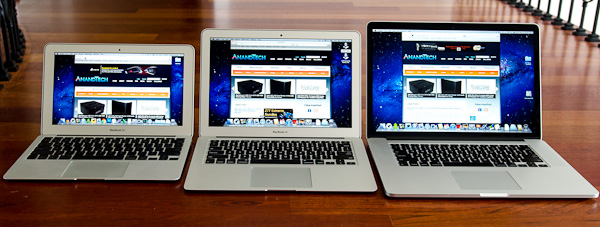
From left to right: 11-inch MacBook Air, 13-inch MacBook Air, MacBook Pro with Retina Display
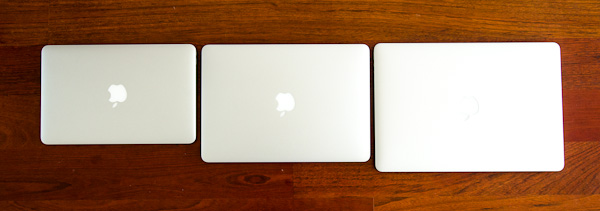
From left to right: 11-inch MacBook Air, 13-inch MacBook Air, MacBook Pro with Retina Display


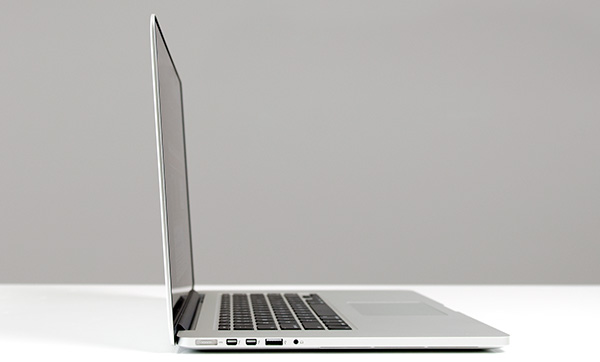
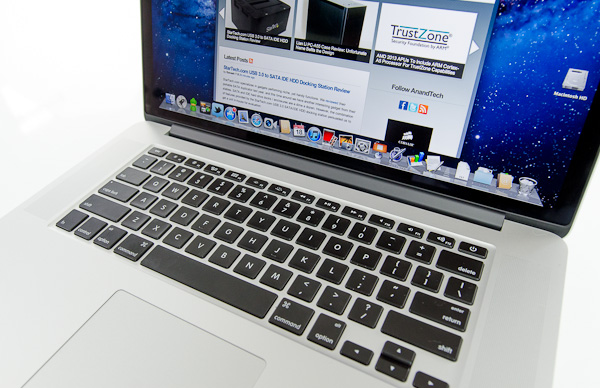
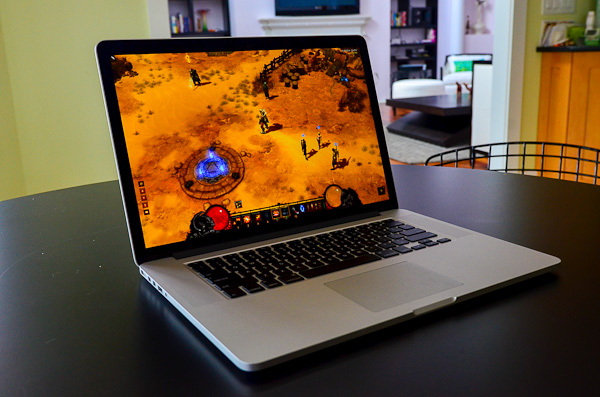
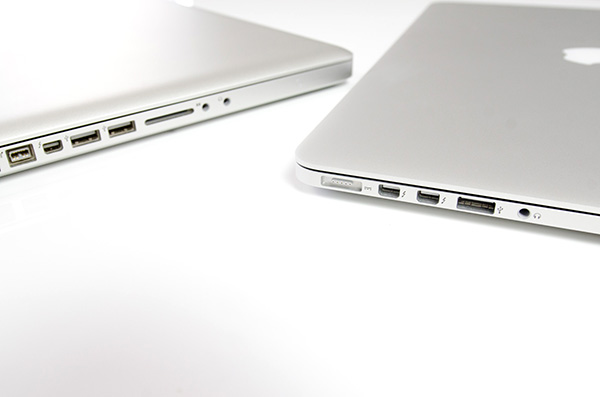
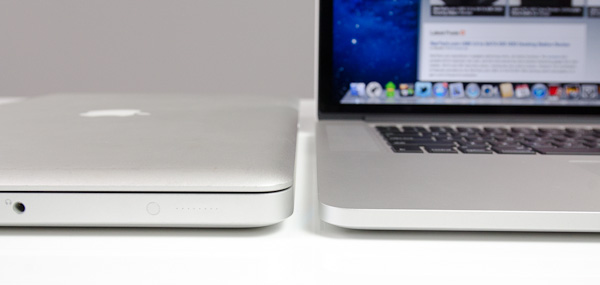








471 Comments
View All Comments
solipsism - Saturday, June 23, 2012 - link
it seems that any major changes to their Macs will come with Retina Displays. The question is when that will come because the iMac and ATDs are likely still to difficult to create and the smaller notebooks likely require more powerful GPUs.As Anand stated Intel is committed to more powerful iGPUs, which I'm fine with as my only concern is not seeing any visual lag and I don't play games, but I do think it's feasible for the 13" MBP to get a Retina Display once that ODD is removed. The only question I have is how much additional size is required to run an IPS display with 4x as many pixels. Can we assume the same battery capacity scaling between the 15" MBP and 15' RMBP?
ananduser - Saturday, June 23, 2012 - link
There is also a price concern. The retina panel on the 15"-er incurs a considerable increase. Lower retina screens on the lesser macbooks will incur themselves a price increase(lower but an increase nonetheless).KoolAidMan1 - Saturday, June 23, 2012 - link
The logic board on the 13" MBP is tiny, not enough room for a dedicated GPU. As it stands, Apple and other ultrabook manufacturers will be leaning on integrated graphics going forward. It is the only solution with chassis getting thinner and lighter. This is a big reason why Intel has been getting so much pressure to improve their IGPs, and Haswell is looking like a huge step in that direction.ananduser - Saturday, June 23, 2012 - link
Come on...Windows supports 200% DPI scaling. By default you have 125% and 150%, but if you go custom mode you can set the DPI slider way up to 200% and any value in between(not just 100% and 200%.OSX' pre-rendering hacks and workarounds do not mean resolution independence. They have achieved a similar result only for their specific configuration. Windows is closer to that ideal as from the start you have the choice to run the native resolution and all scaling can be realized in factors between 100%-200% within that resolution frame. From a software perspective it is more agnostic, therefore more elegant. You're too selfish in your Apple desires that you don't think about custom configurations and myriad of panel choices out there.
Super56K - Saturday, June 23, 2012 - link
I would never describe windows dpi scaling as elegant.Taft12 - Monday, June 25, 2012 - link
It's quite elegant. Windows software support for DPI scaling is not.Spoony - Saturday, June 23, 2012 - link
Quartz supports fully resolution agnostic layout, transforms, and compositing on a per-object basis. It also absolutely supports real resolution independence at any scaling value you desire. See this image from Mac OS 10.4:http://origin.arstechnica.com/images/tiger/scalabl...
Your move, smartypants.
ananduser - Saturday, June 23, 2012 - link
First of all Anand doesn't seem to know Windows well enough to go beyond presets.2nd of all, past OSX implementation of scaling was 2nd rate to that of Windows. OSX was unusable on high res screen without magnifying. I don't need to search for a longstanding macrumors post that described the frustrations of being a macuser on high res(and relatively small diagonal) past desktops.
3rd: internal rendering beyond the panel resolutions and then readjusting is anything but elegant. It is a specific workaround to a specific situation of a specific machine. Apple can't expect the entire world to rework everything to fit their quirky rendering.
Spoony - Saturday, June 23, 2012 - link
That's total garbage, and I suspect you know it.OS X has gone through various stages of teething with resolution independence. It was generally workable, but not always incredibly pretty. I remember U/I cracks and other uglies aplenty. However, setting to native res on a high-res panel and upscaling to 1.25x or 1.5x was very usable and very crisp, cracks aside.
Apple has always been interested in doing resolution independence right, from OS X's beginnings and using PDF as the specification template for their drawing layer. The fact of the matter is, Mountain Lion (and Lion for now) is executing a fully resolution independent desktop, and executing it very elegantly. Much more comprehensive and capable than Windows presently.
Furthermore, Apple has built up a very nice tool set of APIs that allow it (and third parties) to create a slick experience. For now, Windows can't touch it... however, I dearly hope Microsoft fixes this right up promptly. All OSs properly handling dense displays will be a great thing going forward.
ananduser - Saturday, June 23, 2012 - link
MS has nothing to fix as W8 is great from all standpoints. It is Anand's lack of knowing Windows settings that makes him state otherwise.Apple achieved a "resolution independence" type experience through presets. It only works with their available presets and makes use weird workarounds, while obfuscating panel res choices. If you apply a certain patch on OSX, unlock resolution choice and select the native res manually(or any other res) you'll see how resolution independent OSX is not.
You're naive if you think that all the possible past and current OSX 3rd party apps will do out-of-bound patches just to match, I repeat, a specific machine and it's specific pre-rendering routines.
Resolution independence in use is completely panel and resolution agnostic. No matter the native resolution of the panel you can scale the elements by any scale you wish. You do not need to pre-render, then cut the screen to fit your panel. Both os-es lack this effectively but OSX was traditionally worse than Windows.
Note: The true idealistic notion of resolution independece does not exist. Even ios is not resolution independent, it seems so because ios works only on two, integer scaled resolutions.